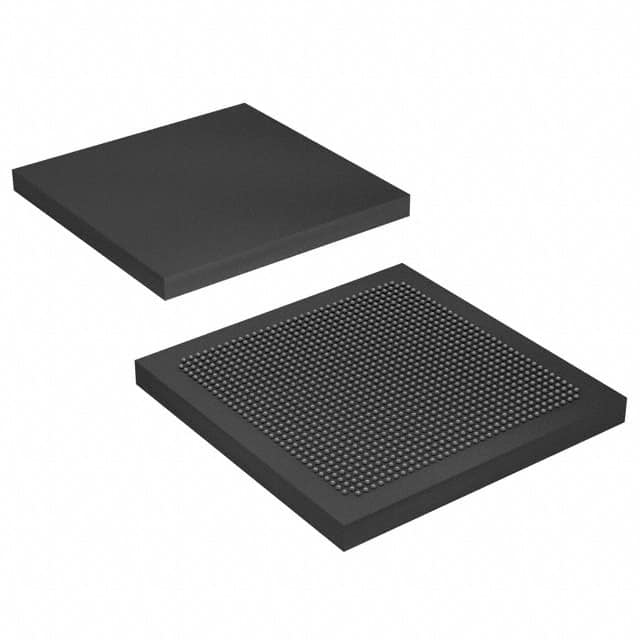5SGXMA7K3F35C3
Basic Information Overview
- Category: Integrated Circuit (IC)
- Use: Programmable Logic Device (PLD)
- Characteristics: High-performance, low-power consumption, high-density, and reconfigurable
- Package: Flip-chip BGA (Ball Grid Array)
- Essence: FPGA (Field-Programmable Gate Array)
- Packaging/Quantity: Single unit
Specifications
- Family: Stratix V
- Device: 5SGXMA7K3F35C3
- Logic Elements: 731,000
- Embedded Memory: 34,816 Kbits
- DSP Blocks: 2,530
- Transceivers: 96
- I/O Pins: 1,040
- Operating Voltage: 1.0V
- Speed Grade: -3
Detailed Pin Configuration
The detailed pin configuration for 5SGXMA7K3F35C3 can be found in the datasheet provided by the manufacturer.
Functional Features
- High-performance architecture with advanced routing and logic resources
- Low-power consumption design for energy-efficient applications
- High-density integration of logic elements, memory, DSP blocks, and transceivers
- Reconfigurable nature allows for flexibility in implementing complex digital designs
- Support for various communication protocols and interfaces
- Built-in security features to protect intellectual property
Advantages
- Offers a large number of logic elements and embedded memory for complex designs
- High-speed transceivers enable high-bandwidth data transfer
- Low-power consumption makes it suitable for battery-powered devices
- Reconfigurability allows for easy updates and modifications to the design
- Advanced routing resources ensure efficient signal propagation
Disadvantages
- Higher cost compared to fixed-function integrated circuits
- Steeper learning curve for programming and configuring the FPGA
- Limited availability of alternative models with similar specifications
Working Principles
5SGXMA7K3F35C3 is based on the FPGA technology, which allows users to program and configure the device according to their specific requirements. The device consists of a large number of configurable logic elements interconnected through programmable routing resources. These logic elements can be programmed to perform various digital functions, while the routing resources enable the interconnection of these elements. The reconfigurable nature of the FPGA allows for flexibility in implementing complex digital designs.
Detailed Application Field Plans
- High-performance computing systems
- Digital signal processing applications
- Communication and networking equipment
- Industrial automation and control systems
- Aerospace and defense systems
- Video and image processing applications
Detailed and Complete Alternative Models
- 5SGXEA7N2F45C2
- 5SGXEB7R2F40C2
- 5SGXEB9R2F40C2
- 5SGXEB9R2F43C2
- 5SGXEB9R2F43I2
These alternative models offer similar specifications and functionality to 5SGXMA7K3F35C3, providing options for different design requirements.
Note: The content provided above is a sample structure for an encyclopedia entry and may not reflect actual specifications or details of the mentioned product.
Lista 10 Vanliga frågor och svar relaterade till tillämpningen av 5SGXMA7K3F35C3 i tekniska lösningar
Sure! Here are 10 common questions and answers related to the application of 5SGXMA7K3F35C3 in technical solutions:
Q: What is the 5SGXMA7K3F35C3 FPGA used for? A: The 5SGXMA7K3F35C3 FPGA is commonly used in various technical solutions that require high-performance processing, such as data centers, telecommunications, and industrial automation.
Q: What are the key features of the 5SGXMA7K3F35C3 FPGA? A: The key features of this FPGA include a large number of logic elements, high-speed transceivers, embedded memory blocks, DSP blocks, and support for various communication protocols.
Q: Can the 5SGXMA7K3F35C3 FPGA be reprogrammed? A: Yes, FPGAs are programmable devices, and the 5SGXMA7K3F35C3 can be reprogrammed multiple times to implement different functionalities or algorithms.
Q: What kind of applications can benefit from using the 5SGXMA7K3F35C3 FPGA? A: Applications that require high-speed data processing, real-time signal processing, complex algorithm implementation, or hardware acceleration can benefit from using this FPGA.
Q: Does the 5SGXMA7K3F35C3 FPGA support high-speed serial communication? A: Yes, this FPGA has built-in high-speed transceivers that support various protocols like PCIe, Ethernet, USB, and more.
Q: Can the 5SGXMA7K3F35C3 FPGA interface with external memory? A: Yes, it has embedded memory blocks and also supports interfacing with external memory devices like DDR3 or DDR4 SDRAM.
Q: What development tools are available for programming the 5SGXMA7K3F35C3 FPGA? A: Intel Quartus Prime is the commonly used software tool for designing, programming, and debugging FPGAs, including the 5SGXMA7K3F35C3.
Q: Can the 5SGXMA7K3F35C3 FPGA be used in safety-critical applications? A: Yes, this FPGA can be used in safety-critical applications, but additional measures need to be taken to ensure functional safety, such as redundancy and fault-tolerant designs.
Q: Is the 5SGXMA7K3F35C3 FPGA suitable for low-power applications? A: No, this FPGA is not specifically designed for low-power applications. It is more suitable for high-performance applications where power consumption is not a primary concern.
Q: Are there any reference designs or application notes available for the 5SGXMA7K3F35C3 FPGA? A: Yes, Intel provides reference designs, application notes, and documentation to help developers get started with the 5SGXMA7K3F35C3 FPGA and implement various functionalities efficiently.
Please note that the specific details and answers may vary depending on the context and requirements of the technical solution.


